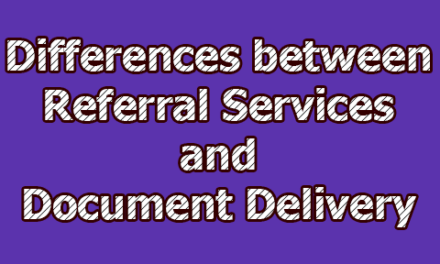Reference Books:
A reference book, as described in the passage, is a type of book that is specifically designed to be consulted briefly to obtain specific information. Reference books are typically organized in a way that makes it easy for readers to quickly locate the information they need without the need for continuous reading. Reference books are not intended for cover-to-cover reading but rather for quick reference or consultation.
Some common examples of reference books include dictionaries, encyclopedias, atlases, almanacs, directories, and various types of handbooks or guides. These books are valuable resources for finding facts, definitions, statistics, and other specific pieces of information quickly and efficiently.
In summary, reference books are written or compiled to serve as convenient sources of information for readers, allowing them to access specific information without the need for extensive reading or exploration of the entire book.
Characteristics of Reference Books:
A reference book is organized and managed in a particular manner to fulfill a specific purpose. The following are some characteristics of reference books:
1. Occasional Consultation: Reference books are not typically meant for cover-to-cover reading. They are designed to be consulted sporadically when a reader requires specific information. People turn to reference books when they have a particular question or need to verify a fact.
2. Definite Items of Information: Reference books are used to find precise and well-defined pieces of information. For example, if someone wants to know the population of a particular city, the definition of a specific term, or the chemical formula of a compound, they would consult a reference book.
3. Wide Range of Sources: To ensure accuracy and comprehensiveness, reference books compile information from a diverse range of sources. This may include authoritative texts, government publications, academic research, historical records, and more.
4. Miscellany of Information: Reference books are like treasure troves of information and facts. They encompass a broad spectrum of topics, making them versatile tools for a wide range of inquiries, from geography and history to science and language.
5. Convenient and Quick Recall: The arrangement of information in reference books is carefully organized to facilitate rapid access. Whether it’s an alphabetical listing of words in a dictionary or a chronological timeline in a history reference, the structure is intended to allow users to locate information quickly.
6. Method of Arrangement: Different types of reference books may employ various methods of arrangement. For instance:
-
- Dictionaries: Alphabetical arrangement of words or terms.
- Encyclopedias: Often a combination of alphabetical and thematic organization.
- Almanacs: Chronological order, often by date.
- Directories: Typically organized by categories or fields.
7. Surface-Level Information: Reference books provide concise and surface-level information. They offer quick summaries or overviews of topics and are not meant for in-depth exploration or analysis. Instead, they serve as starting points for further research.
8. Focus on Facts: Reference books prioritize factual and objective information. They aim to provide accurate data and are not inclined towards presenting opinions, interpretations, or subjective content.
9. Library Use Only: Many libraries restrict reference books from being borrowed, ensuring they remain available for all patrons within the library. This policy ensures that these valuable resources are readily accessible to anyone who needs them.
10. Organized Accessibility: Information in reference books is organized in a way that promotes easy access. Tables of contents, indexes, cross-references, and clear headings help users quickly locate the specific information they seek, regardless of their prior knowledge of the topic.
In essence, reference books are meticulously designed to be practical and user-friendly references for acquiring specific information efficiently. Their organization and content make them indispensable tools for academic research, professional inquiries, and everyday fact-checking needs.
Types of Reference Books:
Reference books encompass a diverse array of specialized resources designed to provide quick and accurate information on specific topics. They serve as indispensable tools for researchers, students, professionals, and individuals seeking precise answers and reliable facts in various fields. The following are several types of reference books:
1. Language Dictionary: Language dictionaries are like linguistic treasure chests, carefully curated to provide a wealth of information about a particular language. Beyond mere word definitions, they offer insights into the intricate nuances of language, including pronunciation guides, multiple-word meanings, and real-world usage examples. These references are indispensable tools for language enthusiasts, students, writers, and anyone seeking to master a language. They also come in specialized forms, delving deep into fields like medicine, law, or technology, ensuring that precise and accurate language usage is at everyone’s fingertips.
2. Encyclopedia: Encyclopedias are intellectual treasure troves, akin to mini-libraries encapsulating the breadth of human knowledge. Within their pages lie concise yet comprehensive articles, each penned by experts in their respective fields. They are a testament to the collective wisdom of humanity, serving as invaluable references for curious minds. Encyclopedias can be general, providing an expansive overview of human knowledge, or highly specialized, offering deep insights into specific domains like astronomy, history, or biology. In the digital age, platforms like Wikipedia have democratized access to encyclopedic information, allowing users to contribute and expand this ever-evolving repository of knowledge.
3. Biographical Sources: Biographical sources are like windows into the lives of remarkable individuals. They offer a glimpse into the stories, accomplishments, and contributions of notable figures throughout history and across various fields. Biographical dictionaries provide succinct profiles, ideal for quick reference and fact-checking. Autobiographies, on the other hand, offer deeply personal narratives, allowing readers to step into the shoes of these remarkable individuals. Biographical encyclopedias provide extensive and meticulously researched accounts, offering a comprehensive understanding of the lives and legacies of those who have shaped our world.
4. Directories: Directories are the organized databases of the physical world, serving as invaluable tools for locating people, businesses, and organizations. Telephone directories provide the contact details of individuals and households, connecting friends and family. Business directories are essential for entrepreneurs and professionals, offering insights into the corporate landscape. Organizational directories unveil the structures and contacts within various institutions, associations, and government bodies. Whether you’re searching for a long-lost friend or identifying potential business partners, directories are the go-to references for contact information.
5. Bibliographies: Bibliographies are the bibliophile’s treasure map, guiding researchers and scholars to a wealth of relevant literature. These meticulously curated lists of books, articles, and other publications are akin to curated reading lists, ensuring that researchers do not overlook crucial sources. Annotated bibliographies go the extra mile by providing brief summaries and evaluations of each listed work, aiding in source selection. In the world of academia, bibliographies are the compasses that lead researchers on their intellectual journeys, ensuring they have a comprehensive and well-informed understanding of their chosen field.
6. Audiovisual Materials: Audiovisual reference materials are the immersive classrooms and theaters of the digital age. They encompass a diverse array of formats, from CDs and DVDs to online lectures and interactive multimedia platforms. These resources transform learning experiences by incorporating auditory and visual elements, making complex concepts more accessible. They cater to diverse learning styles and provide engaging ways to explore subjects ranging from history and science to art and music. In a world where information is increasingly multimedia-rich, these references offer a dynamic and interactive approach to education and entertainment.
7. Yearbooks, Almanacs, and Supplements to Encyclopedias: Yearbooks are like time capsules, encapsulating the essence of a specific year’s events, statistics, and developments. Almanacs, on the other hand, are annual companions, offering a blend of astronomical data, weather predictions, and historical trivia. Supplements to encyclopedias serve as vital updates, ensuring that reference works remain current in our ever-evolving world of knowledge. These references provide a fascinating journey through time, offering insights into the past, present, and future, making them indispensable for historians, researchers, and the curious-minded.
8. Geographical Sources, Gazetteers, Guidebooks, Maps, Atlases, etc.: Geographical references are passports to the world. They are like geographical toolkits, equipping travelers, students, and researchers with the tools they need to explore and understand the Earth. Maps and atlases provide visual representations of geographic features, aiding in navigation and geographical comprehension. Gazetteers are encyclopedic guides to places, offering detailed information about locations, landmarks, and geographical characteristics. Guidebooks are indispensable for travelers, providing insights into destinations, cultures, and attractions, making them essential companions for exploration and adventure.
9. Current Sources: Handbooks, Manuals, and Sources of Statistics: Handbooks and manuals are like expert companions, providing practical guidance and procedural knowledge in various fields. From technical manuals for complex machinery to employee handbooks for organizational policies, these references ensure that individuals have the information they need to navigate specific situations. Sources of statistics are dynamic references, offering up-to-date data and analyses on a wide range of topics, including demographics, economics, and public health. These references empower decision-makers, researchers, and professionals with the latest information to inform their actions and strategies.
10. Thematic References: Thematic references are specialized reference books that focus on a particular subject, theme, or area of interest. They are like expert guides into specific domains of knowledge, providing in-depth information and analysis. These references cover a wide range of topics, from art and music to science and technology, catering to enthusiasts and researchers seeking comprehensive and authoritative insights within their chosen fields. Whether you’re delving into the depths of astronomy or exploring the intricacies of culinary arts, thematic references offer a deep dive into specialized knowledge.
Each of these types of reference books serves as a valuable resource, catering to diverse needs across academia, professional fields, and personal interests. They are essential tools for accessing accurate and reliable information quickly and efficiently, enriching our understanding of the world and the knowledge it holds.

Library Lecturer at Nurul Amin Degree College










